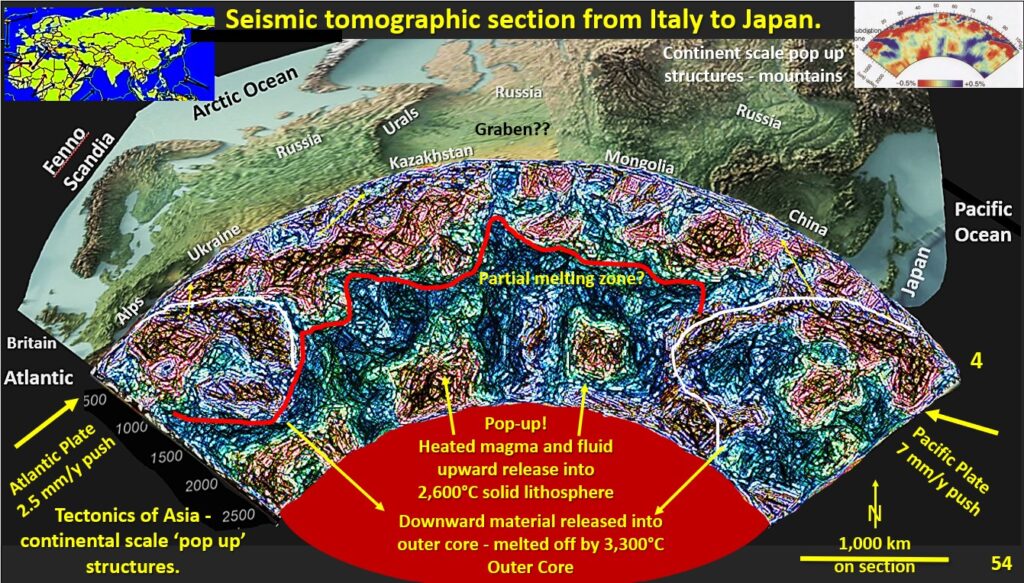I have seen very little published research covering this huge area from the surface to the Outer Core as a single geological entity . As far as I have been able to ascertain the detailed structural geology beneath Europe, Russia to Japan down to the core is not known. So here is a first for you to relish! Correct me, as usual, if I am in error.
Collision versus Subduction zone tectonics.
The section is extremely interesting and shows many geological structures not currently known.
On the left-side of the section the Africa/Europe collision zone is seen under the white outline. If you compare this collision zone to the Japanese subduction zone on the right-side it is observed that the collision zone only gets about halfway down to the core but the Japanese subduction zone, just like the South and North American subduction zones, extends right to the core with the cool subducted material (2,400°C) thrust into the 4,500°C – 5,500°C Outer Core and digested.
Estimate of subducted material.
I did a quick calculation of the amount of earth material that the subduction zones thrust into the liquid Outer Core each year this amounted to raising the continental area of Earth seven millimetres each year! This huge amount of material totally over pressurises the centre of the Earth which then cracks the lithosphere forming the huge plate boundary and internal boundary sub-vertical cracks.
This overpressure and upward release under the continents can be seen under Russia.
Mountainous versus graben areas.
The red heat sources under Russia, above the Outer core, are symmetrical either side of a central graben area. These heat sources form the mountains in Mongolia and China in the east-side and are under Ukraine, through to the Ural Mountains in Russia on the west-side. In between these is the central Siberian Graben which has a huge vertical structure under it right from the outer core to the surface. Is this Mid Russian Ridge a incipient version of the Mid Atlantic Ridge and the African Rift?
When seen in plan large sub-vertical structure just to the east of the Africa/Europe collision zone, and surfacing through Ukraine is the northern extension of the African Rift System.
Long-lived Fluid channelways.
There are strong vertical fault systems coming up from the outer core under China and Japan on the right-side of the section. These are identical to the vertical fault systems cutting up through the subduction zones in South and North America and I believe are the primary channelways for fluid migration, forming mineralisation.
One must wonder how long-lived these subvertical structures and others like the African Rift and the Mid Atlantic Ridge are as they appear to take no notice of the continental drift that happens during Earth’s Evolution.
This figure shows the EagleEye seismic tomography section with the seismic tomography plan at 225 km depth draped around the top and a 2775 km depth seismic tomorrow plan draped around the bottom.
The contorted zones at the top left-hand are the mountains in Europe and Western Russia and right-hand are those in Mongolia through to Japan. They correlate very well with the contorted zones in the 220 km seismic tomographic section. The much less contorted zone in the middle corresponds with the blue, less contorted zones in the tomographic section and lie under the Russian Central Graben.
Outer Core heat sources.
The main red areas of heat in the 2775 km depth seismic tomographic plan at the bottom correlate with the rising red heat areas in the section. The correlation of these finer details is further evidence of the veracity of the EagleEye data.
Mobile Mantle and Lava Lamp Plumes.
This new detailed data on the seismic tomographic section shows there is brittle structural geology from the surface to the Outer Core . These structures cut the collision and subduction zones and the red heat sources and right through where any mobile mantle should exist. So as I have questioned before – do they exist.
Conclusion
The ability to be able to get structural geology from these hemisphere spanning seismic tomographic sections and plans has revealed the intricate geologic structures associated with Europe/Asia and gives unprecedented ability to determine Earth’s global tectonics and its evolution.
Happy tectonicsing (new word)!
Cheers
Bob

